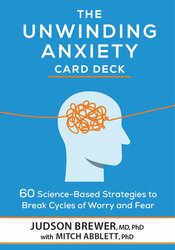Breaking the Anxiety Habit Loop: A Mindful Approach to Rewiring Clients' Responses

Anxiety is one of the most common threats affecting mental health patients every day. Researchers from the World Health Organization found that, in 2019, 301 million people were affected by anxiety worldwide. Help your clients reframe anxiety as they know it. Mental health experts Jud Brewer, MD, PhD, and Mitch Abblett, PhD describe anxiety as a repetitive habit or "loop" that clients often feel caught in. This structured approach, divided into three practical "gears," helps clients understand their anxiety patterns and adopt mindfulness-based strategies that provide a healthier alternative to rumination, worry, and panic.
The three gears of anxiety are:
A similar process happens with anxiety, as it becomes a learned habit that forms its own loops in the brain. This can manifest as worry loops, avoidance loops, rumination loops, and more. Understanding anxiety in this way allows us to help clients recognize these loops as patterns that the brain has adopted over time, enabling us to work with them on creating healthier alternatives.
Ask your clients to make a list of specific situations that trigger anxiety. This can help visualize the beginning of the habit loop. Ask them what behaviors follow the trigger, then ask them to reflect on the results of this behavior. This helps to visualize each anxiety loop and makes it feel a lot easier to tackle. This method can be used to help clients understand other toxic habit loops such as avoidance, procrastination, worry, and more.
When guiding clients through these practices, encourage them to ask, "What do I get from this behavior?" This reflection helps them assess how helpful or unhelpful their anxiety loops truly are, providing an opportunity to recalibrate the brain’s reward system. By doing so, clients can begin replacing their anxiety-driven habits with more effective, supportive actions.
One helpful exercise to promote this is to encourage clients to greet anxiety with an open hand. Guide your clients through this practice to explore whether a fixed or growth mindset feels more supportive in addressing their anxiety habit loops:
One way to do this is to review one of the TBR loops you've mapped with your client and encourage them to ask, “What do I actually get from this behavior?” Then guide them through the RAIN process:
This allows clients to consistently recognize their anxious thoughts and sensations, helping them develop a heightened awareness of their anxiety triggers. This recognition helps them identify anxiety earlier in the cycle, giving them the chance to mindfully respond rather than impulsively react. Through regular practice of these methods, clients become more comfortable allowing anxiety to exist without immediately trying to suppress or fix it. This acceptance doesn’t mean resignation; rather, it fosters a healthier relationship with discomfort, teaching clients that they can coexist with difficult emotions without letting them control their actions.
The three gears of anxiety are:
- 1st Gear: Assist clients in identifying and mapping their current anxiety habit loops.
- 2nd Gear: Support clients in increasing their awareness of these loops and in re-evaluating their brain’s perception of the reward tied to these anxious habits.
- 3rd Gear: Guide clients in using mindfulness practices to disengage from anxiety loops, encouraging them to step into more adaptive and supportive experiences.
1st Gear
The main idea of the first gear is to map anxiety habits. Habits only need three elements to form: a trigger, a behavior, and a result; these are known as TBR habit loops. The earliest instances of habits occurred when our ancestors developed certain survival habits to remember where to find food. For instance, after they ate something, their stomach would send a signal to their brain, reinforcing the memory of what they ate and where they found it, creating a habit loop.A similar process happens with anxiety, as it becomes a learned habit that forms its own loops in the brain. This can manifest as worry loops, avoidance loops, rumination loops, and more. Understanding anxiety in this way allows us to help clients recognize these loops as patterns that the brain has adopted over time, enabling us to work with them on creating healthier alternatives.
Ask your clients to make a list of specific situations that trigger anxiety. This can help visualize the beginning of the habit loop. Ask them what behaviors follow the trigger, then ask them to reflect on the results of this behavior. This helps to visualize each anxiety loop and makes it feel a lot easier to tackle. This method can be used to help clients understand other toxic habit loops such as avoidance, procrastination, worry, and more.
2nd Gear
Once your client has understood their anxiety loops, it’s time to kick it up a gear. Gear 2 calls clients to be more mindful of how their anxiety loops are affecting them. Mindfulness encourages clients to become aware of their thoughts, emotions, and bodily sensations. At its core, mindfulness is about paying attention intentionally, with kindness and openness, to what is happening in the present moment.When guiding clients through these practices, encourage them to ask, "What do I get from this behavior?" This reflection helps them assess how helpful or unhelpful their anxiety loops truly are, providing an opportunity to recalibrate the brain’s reward system. By doing so, clients can begin replacing their anxiety-driven habits with more effective, supportive actions.
One helpful exercise to promote this is to encourage clients to greet anxiety with an open hand. Guide your clients through this practice to explore whether a fixed or growth mindset feels more supportive in addressing their anxiety habit loops:
- Start by reviewing the TBR (Trigger-Behavior-Reward) habit loops they identified in the first gear.
- Have them clench one hand into a fist while they imagine one of these loops. Encourage them to reflect on what this loop might provide.
- Direct their attention to the sensations in their fist. Ask them to notice how this tight or fixed position feels. Is there any tension, judgment, or negativity?
- Then, invite them to slowly open their hand and relax it, paying attention to the change in sensation. As their hand opens, prompt them to consider whether they might be open to learning what does and doesn’t work about this loop.
- Finally, help them reflect: Which feels more helpful—a rigid, fixed mindset or a flexible, growth-oriented mindset?
3rd Gear
When the brain begins to lose interest in old habits that no longer serve it, it opens the possibility for new, more beneficial habits to take root. The brain instinctively seeks out rewarding experiences—what we call BBOs, or bigger, better offers. Sometimes, experiencing a BBO can be as simple as encouraging clients to step outside of an old, familiar pattern. In 3rd gear, you’ll explore how mindfulness practices can support clients in making this shift.One way to do this is to review one of the TBR loops you've mapped with your client and encourage them to ask, “What do I actually get from this behavior?” Then guide them through the RAIN process:
- Recognize the sensations and thoughts arising in their body and mind.
- Allow these experiences to be present without judgment or avoidance.
- Investigate the experience with gentle curiosity, neither pushing it away nor clinging to it.
- Notice how it feels to approach themselves with self-compassion instead of self-criticism.
This allows clients to consistently recognize their anxious thoughts and sensations, helping them develop a heightened awareness of their anxiety triggers. This recognition helps them identify anxiety earlier in the cycle, giving them the chance to mindfully respond rather than impulsively react. Through regular practice of these methods, clients become more comfortable allowing anxiety to exist without immediately trying to suppress or fix it. This acceptance doesn’t mean resignation; rather, it fosters a healthier relationship with discomfort, teaching clients that they can coexist with difficult emotions without letting them control their actions.
Mindfulness in Psychotherapy Certification

Discover advanced mindfulness techniques with leading experts like Mark Epstein, MD, and Susan Pollak, MEd. Gain actionable strategies and resources to guide clients through grief, trauma, addiction, and more. Earn FREE certification and exclusive course bonuses.
The Unwinding Anxiety Card Deck

Based on Dr. Brewer’s New York Times bestselling book Unwinding Anxiety, this deck features 60 research-based practices to help you identify and overcome unhelpful anxiety responses, or habits, that prevent you from living life to the fullest. Grounded in the science of mindfulness, each exercise harnesses the brain’s innate power to create new responses to anxiety triggers.
Meet the Expert:
Jud Brewer, MD, PhD ("Dr. Jud") is a New York Times bestselling author and thought leader in the field of habit change and the "science of self-mastery," who blends over 20 years of experience with mindfulness training and a career in scientific research. He is passionate about understanding how our brains work, and how to use that knowledge to help people make deep, permanent change in their lives – with the goal of reducing suffering in the world at large.
Dr. Brewer is the director of research and innovation at Brown University’s Mindfulness Center, where he also serves as an associate professor at the Schools of Public Health and Medicine at Brown University. Additionally, he is the chief medical officer at Sharecare, a digital health company, and a research affiliate at MIT.
Learn more about his educational products, including upcoming live seminars, by clicking here.
Dr. Brewer is the director of research and innovation at Brown University’s Mindfulness Center, where he also serves as an associate professor at the Schools of Public Health and Medicine at Brown University. Additionally, he is the chief medical officer at Sharecare, a digital health company, and a research affiliate at MIT.
Learn more about his educational products, including upcoming live seminars, by clicking here.



